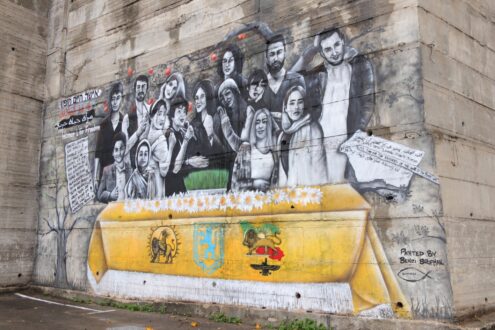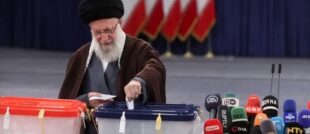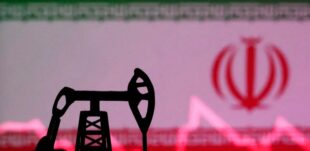iranintl – Natalie Sanandaji, a survivor of the October 7 atrocities, stood before a virtual panel this week to show a shared unity between Iranians and Israelis that she believes many either overlook – or are unaware of.
“We are not enemies. We’re allies in the fight against a shared enemy,” said the 28-year-old Natalie Sanandaji.
Hosting a digital rally, Sanandaji declared that the common enemy for both Iranians and Israelis is the Islamic Republic of Iran.
“I survived an Iranian-led attack at the Nova music festival in Israel, which only strengthened my resolve to fight for my fellow Iranians living in fear under the regime,” she said.
She was attending the Re’im music festival on October 7 when Hamas launched attacks. Out of the nearly 1,200 people killed that day, at least 364 were young partygoers at the festival.
Hearing gunfire from all directions, she ran for hours, passing by some who were killed on their way trying to escape the carnage. She ran until an Israeli local came to her rescue, according to reports.
Sanandaji was born to an Iranian father and an Israeli mother. Her background, she said, has often led to misconceptions with people.
“I’m Iranian and Israeli, their automatic reaction was, what’s it like to be from two countries that hate each other? What’s it like? To have parents from two cultures who hate each other. And I would always have to explain to people. It’s not. It’s not the people. They don’t hate each other.”
On June 23, she hosted the “Voices Against Violence: The Iranian Diaspora Speaks” Digital Rally, organized by the Combat Antisemitism Movement. The event united voices from the Iranian diaspora to address issues of human rights violations by the Islamic Republic of Iran.
“It started in Iran, and a lot of people seem to not realize that Hamas is just one of the proxies of the Islamic regime. And it’s so it’s so important to have that unity, because that’s what they want more than anything. They want us to not be unified against all of them. They want us to not realize that they are all one and that we have one common enemy,” said Sanandaji.
On October 26, 2023 Congressman Bill Huizenga, the Chairman of the House Financial Services Subcommittee on Oversight and Investigations, held a hearing examining how the Iranian regime moves money to finance terrorism. He stated that Iran funds roughly 93% of Hamas’ budget which is about $350 million dollars per year.
In 2018, the US State Department report stated that Iran funds Hezbollah with around $700 million annual and gives $100 million a year to groups like Hamas and Palestinian Islamic Jihad.
Behnam Ben Taleblu, a senior fellow at the Foundation for Defense of Democracies (FDD), told Iran International, Iran uses its proxies like Hamas to avoid the prospects for a direct and over confrontation.
“Proxy forces function as low cost auxiliaries for the Islamic Republic, allowing the regime in Tehran to conserve resources and personnel by fighting on the cheap and using local actors as shock troops and terrorist forces,” said Taleblu.
The lineup of the digital rally speakers, including activists, scholars, and community leaders, expressed that at the acts of violence committed in Iran against its own people and through its proxies abroad like in Israel, are the same.
Marjan Keypour, a human rights activist and advocate for women and minorities in Iran, implored the West, specifically feminists to condemn the atrocities of the Iranian regime.
“I’m speaking specifically to the feminists around the world, especially in the Western countries, who have time and again ignored the atrocities that are committed by the Iranian regime and their perpetrators across the world. For them to speak out with the same vehemence and with the same level of condemnation against the violence that is taking place inside Iran and against the violence that took place on October 7th by the Iranian regime proxies. We cannot forgive. We cannot forgive. We cannot ignore,” she said.
Jonathan Harounoff, an Israeli-Iranian expert and journalist, said the “bond between Israelis and Iranians is one of the most misunderstood dynamics in this entire conflict.”
Harounoff said the reason there’s a strong bond is because they share the same “source” of “suffering” and share a “the same sort of lived experiences.”
“Iranian people, they’ve been suffering for decades and decade from the Islamic Republic. Israelis and Jewish people worldwide have have suffered at the hands of the Islamic Republic, whether directly or, through its, very vast proxy network,” he said.
Another featured speaker, Sarah Raviani, a visiting fellow with the National Union for Democracy in Iran (NUFDI), drew parallels between the death of Mahsa Amini, which she said created a “revolution in all of our hearts” and the victims of October 7.
Amini was killed in Sept 2022 after being taken into police custody for allegedly not wearing her hijab properly. Her death sparked the Woman, Life, Freedom protest movement in Iran, and became a rallying cry for change.
Raviani said when the movement broke out, “for all of 2022 and 2023, the Israeli and Jewish community were basically our only allies.”
She said when October 7 took place she felt like all of her advocacy against the Islamic Republic had “fallen on deaf ears.”
“I woke up that morning very, very early. It was around 5 a.m. and for around an hour I sat on social media as I watched videos of Hamas hunting down Israelis, and I remember calling my mom. I was at my parent’s house, and I called my mom over to my bedroom, and I just had her lay down with me, and we were crying and just in shock because, you know, we had been advocating for so long and trying to educate lawmakers on the dangers of the Islamic Republic” she said.
Harounoff said the perpetrators behind the attacks in Israel and against Iranian people inside Iran have the same roots – the Islamic Republic.
The FDD’s Behnam Ben Taleblu said Iran is trying to export its revolution and Islamist, authoritarian agenda abroad through its proxies. That agenda, he said, is not supported by a vast majority of Iranians.
“This is an agenda that has no social base or resonance at home and is increasingly contested by the vast majority of Iranian society which has been protesting against the regime in its entirety.”
American-Israeli expert and journalist Emily Schrader, one of the panelists, said it’s her mission to educate people on the solidarity felt by many Iranians and Israelis. It’s a unity that she believes most of the Western world doesn’t understand.
“I think that one of the most important things that we can do is to show the world that there is this solidarity and to show the world that we do have this common goal of fighting against an Islamist terrorist organization, which is the Islamic Republic of Iran, along with all of its proxies, whether it’s the IRGC, the Houthis, Hezbollah, or Hamas.”
She organized the Woman-Life-Freedom protests in Israel and helped bring murals supports the people of Iran to the streets of Israel.
Schrader described the bond between Iranians and Israeli’s as historic.
“We always loved each other. I mean, speaking historically, of course, from the time of Cyrus the Great, there’s a true allyship between the Jewish people and the Iranian people.”
Israel-Iran expert Jonathan Harounoff agrees. He pointed to the fact that around the world, some Israelis have shown up to anti-regime protests organized by Iranians and that some Iranians have also supported Pro-Israel demonstrations.
“You’ll see flags from both present. You’ll see people who are, waving flags side by side into it. To an outside observer, that seems like a crazy thing. How is that what is going on? But it’s it actually makes a lot of sense that people who are building this bond not just by suffering, but also mutual understanding where Iranians understand where Israelis are coming from, and Israelis also understand where Iranian people are coming from.”
 Shabtabnews In this dark night, I have lost my way – Arise from a corner, oh you the star of guidance.
Shabtabnews In this dark night, I have lost my way – Arise from a corner, oh you the star of guidance.



